Africa or Bust – the Plymouth-Banjul Challenge 2007
Friday, 2 March 2007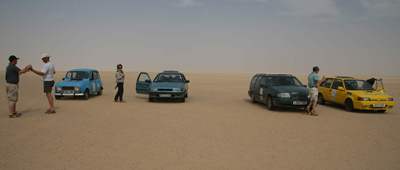
On Friday 2 February Maureen and I will be departing England in a beat up old Mitsubishi to drive the Plymouth-Dakar. You read that right, ‘Plymouth’ not Paris. So it doesn’t start in Paris, and to be honest it doesn’t end in Dakar in Senegal either, it continues on to Banjul in Gambia, next capital down the coast of West Africa.
The other big difference from the Paris-Dakar is the Plymouth-Dakar does not cost a squillion dollars and you don’t drive there very-very-fast. Simply getting there is the key, because when you arrive you must give your car away. They’re auctioned off for African charities.
So we have our car, a 1989 Mitsubishi Colt (a Lancer in some markets), German registered (Berlin) because the cars have to be left-hand-drive (British cars have their steering wheels on the right). It’s waiting for us in Exeter (about 170 miles west of London). We’ve never seen it and about the only thing we know about it is we have to hand over £350 (that’s US$690) before we can drive it away.
We start from the Triangle Car Park at The Serpentine, Hyde Park. London at 10 am on Friday 2 February. We hope some of the other 42 cars starting at the same time as us will also turn up there. Their teams come from England (of course) but also Barbados, Belgium, Dubai, Germany, Ireland (north and south), Netherlands, New Zealand, Norway, Portugal and the USA. As well as our Australian twosome.
Then it’s over (or under) the Channel, down through France and into Spain. If our Mitsubishi, dubbed ‘The Original Lonely Planet,’ keeps going we’ll be at Tarifa (near Gibraltar) on 4 and 5 February, Marrakech in Morocco on 8 February, Dakhla in Morocco on 12 February, Nouuakchott in Mauritania on 17 February, Zebrabar in Senegal on 18 and 19 February and finally, 6000km from our starting point, in Banjul on 21 February.
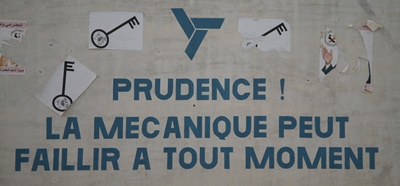
A Sahara warning sign, your car could collapse at any moment!
Friday 2 February
Our ‘trusty’ (I’m going to keep saying that) Mitsubishi sat by a wall in the Dorset village. I’d handed over the £350 (yes, we’d paid more than the target £100), it was ours. The trouble was we can’t see it in the dark, but we get in, I turn the key, it starts, so we drive away. The next morning, in daylight, it looks OK, apart from the flat tyre. But even if there had been air in the spare it would have done us no good if we’d had a puncture, there was no jack.
Next day we drive back to London and circle around various car places to find a jack and a few other vital necessities. Friday 2 February we leave central London and head south, passing so many African hairdressers, African restaurants and African phone card shops it scarcely seems necessary to drive to Africa. At Folkestone we drive on to the Eurotunnel train, no time wasted, we get on standby on the first train going, and 35 minutes later drive away in Calais.
By 6pm we are 400km from London and it’s dark, drizzling with rain and the wipers don’t seem to work. Make it to Alençon for the night where we stay in what feels like a cheap rural American motel (costs €44) and ‘enjoy’ a meal that proves even the French can do dull food when they put their minds to it.
Saturday 3 February
Eventually drag ourselves out of bed (it’s dark outside), grab some breakfast, jump in the ‘trusty’ Mitsubishi and head south. For the whole day. By which time we’ve covered 700km and crossed the border into Spain. At which time the usual travel mysteries kick in. Why do our route notes (downloaded from the RAC UK website) not seem to match up with reality? And when we finally cruise into Vitoria, after dark, why is there not a single hotel anywhere to be found? We circle around, trying to find the city centre, trying to find anything, nearly get sideswiped by a local making a beeline for a vacant parking spot, nearly having a head-on with another local when we turn into a one way street only to find it’s two way, and then suddenly chance upon a hotel with a car park. And a bar. And a very reasonably priced restaurant, where a bottle of very nice red is thrown in with dinner at no extra cost. What’s not to like?
Sunday-Monday 4-5 February
Who are these people turning up for a pre-dawn breakfast at our hotel in Vitoria? The two German-speaking punk-looking guys turn out to be bus drivers for the Leipzig Opera. Our intention to leave ‘early’ doesn’t work that well (I waste a quarter of an hour looking for a working ATM machine), although we still get away by 830pm. And then drive-drive-drive via Madrid, Granada and Malaga to arrive at Tarifa, just beyond Gibraltar and 1077km from our morning starting point at 730pm. We’ve sat most of the day with the speedo needle at a steady 120kph, which left us in the slow lane with everything else whistling past us.
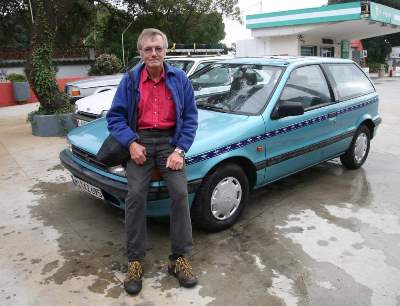
Lots of cars, some of them worse looking than ours, some of them much better, are already assembled and the entrants are already sinking cold cervezas. I like the French blue Renault 4 and the bright yellow American school bus. The next day we spend shopping and meeting our fellow travellers. Africa is a stone’s throw away across the Straits of Gibraltar and a ferry company rep comes round to the hotel at 6pm to sell tickets.
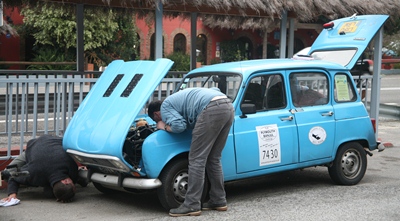
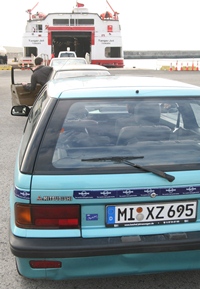 Tuesday 6 February
Tuesday 6 February
Europe to Africa by ferry may only take 45 minutes, but you then kill two hours waiting for the Moroccan customs to get around to performing five minutes of paperwork. Finally we roll out of the dock compound, pull dirhams out of an ATM and spend €50-worth buying 10 days’ car insurance. Then it’s on the autoroute and south to Rabat, a steady procession of oncoming drivers flash their headlights to warn of a quite amazing number of radar speed traps.
Wednesday 7 February
From Rabat we cruised along a modern toll road autoroute via Casablanca to Marrakech for the first two thirds distance, the final 150 km on a rather older road. In Marrakech we dived into the medina to stay at Riad Edward. Converting traditional old Moroccan courtyard houses known as ‘riads’ into hotels is a current trend and this one is a fine example of the type. The problem with riads is finding them, the medina is amazingly convoluted and the riads are usually completely anonymous, from the outside.
Friday 9 February
Thursday was a rest day in Marrakech, we spent part of the day with a German TV crew making a documentary about the hippie trail era of the 1960s and ‘70s. Friday we drove through the Atlas Mountains on a spectacularly winding road through Taroudant and down to Agadir on the coast. At a roadside cafe at 2100 metres we met other Plymouth-Banjul teams stopped for excellent saffron flavoured omelettes, a Berber speciality.
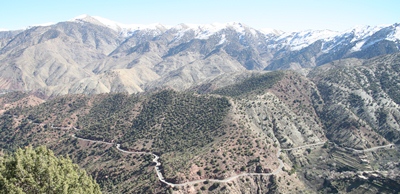
Saturday 10 & Sunday 11 February
Our first vehicle malfunction in Agadir, a puncture fixed for 10 dirham, about US$1.50. Then it’s two long days down the bleak desert coast, overnighting in Laâyoune and finally arriving in Dakhla. In between we’ve seen lots of sand, lots of camels, quite a few other Plymouth-Banjul competitors and an amazing number of French campervans, all of them white and congregating in groups for a thousand km. Everybody is supposed to arrive in Dakhla by tomorrow night and get ready for the push into Mauritania tomorrow.
Monday 12 to Saturday 17 February
We’ve not really been out of touch right through Mauritania, but we never hung around long enough to work things out at local internet cafes (there were quite a few of them). At Dakhla, our final stop in Morocco (in what used to be the old colonial era Spanish Sahara) we met up with most of the other crews. Unhappily the American team’s big yellow school bus (we’d joked about hitching a ride with them if our trusty Mitsubishi broke down) is towed in and it appears the bus is dead.
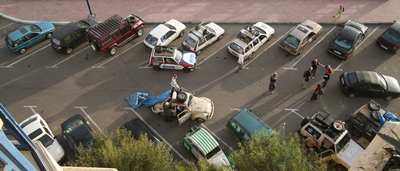
From Dakhla we crossed into Mauritania without problems and teamed up with three other cars (a beautiful little Renault 4 steered by two clockmakers, a gaudy yellow Nissan Sunny coupe and a militarily precise – the crew are both ex-RAF – Volvo station wagon) to cross the desert. In fact you can take the new road from Nouadhibou to Nouakchott, but that’s wimping out, we go for the real deal, across the sandy wastes and down the beach with incoming waves lapping at our wheels.
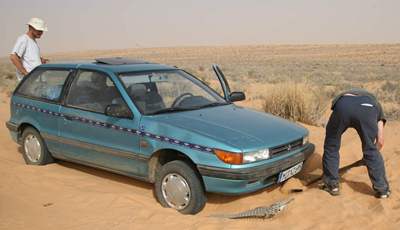
It’s a buzz although the first day I’m the champion at getting stuck in the sand. Fortunately I redeem myself on day two when I’m the champion at not getting stuck in the sand. I’ve mastered the Mitsu sand technique: run into deep sand flat out, with the poor little car’s little 1.3 litre 18 year old, 225,000 km engine running at maximum revs and with luck you sail out the other side.
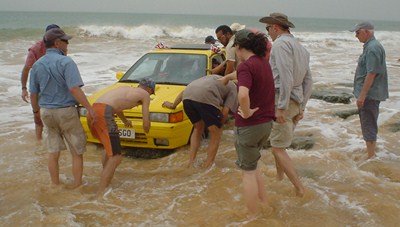
Towards the end of the beach we have to round a rocky promontory by actually driving into the sea and skittering out the other side of the rocks with everything still going. The Mitsu even manages that OK.
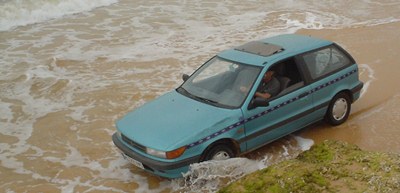
An overnight pause in Nouakchott and then it’s down to the Senegalese border, an experience which puts a bad taste in everybody’s mouth. First we skip the Rosso border (hassles, bribe demands, delays) by driving 100km down a dirt road to a smaller border crossing.
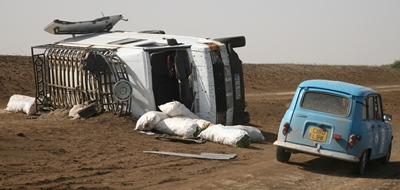
Even there we have to go through nine different checkpoints in about 200 metres, emerging €152 poorer having paid off (usually in bribes) customs officials, police officials, border officials and on and on both exiting Mauritania and arriving in Senegal.
Fortunately we evade the police roadblocks between the border and our campsite at Zebrabar, nearly every other car is stopped and fined for various made up offences. One crew gets gonged for €20 for not signalling as they pulled in when the police stopped them to check if they really had two reflective triangles on board. Most cars in Senegal don’t have an indicator to their name, let alone a reflective triangle.
Sunday 18 to Wednesday 21 February
We hang out at the Zebrabar campsite for three days, travelling the 18km to the colourful town of St Louis by boat. Other teams come and go and on Tuesday we set off with Dan and Ian in their Renault 4 for the last leg to Gambia. We stop at Touba, about halfway, to have a look at the country’s biggest mosque and carry on to Toubakouta for the night. Another team in a Ford Sierra join us there, the Ford has undergone major surgery at Zebrabar when the front bodywork started to collapse.
The next morning we’re up bright and early for the final short drive to the Gambian border at Karang and on to the ferry at Barra. It’s the trip’s final hassle, the ferry is notoriously slow, unreliable and crowded and the ‘bumpsters,’ Gambia’s famous tourist hustlers, are said to be out in force. In fact we don’t suffer any real bumpster problems and only have to wait three hours (while we fry in the sun) for a ferry. Trucks were waiting for days.
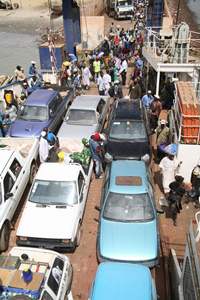 An hour later we’re across the 5km wide river and it’s just 15km to the final checkpoint, the Safari Garden Hotel. We’ve covered 7,206km from when we picked our trusty little Mitsubishi up from the village outside Exeter. As the crow flies (or the GPS indicates) we’re 4,274km from our first night of the trip, on the south coast of England in Torquay. Along the way apart from putting fuel in the tank we’ve had to spend precisely 10 dirham, about US$2, to fix a puncture in Agadir. Other than that it has not skipped a beat. Tomorrow morning I’ll press out the dents we put in the front wings (fenders for Americans) when we were pushing the poor little thing out of a sand dune in Mauritania.
An hour later we’re across the 5km wide river and it’s just 15km to the final checkpoint, the Safari Garden Hotel. We’ve covered 7,206km from when we picked our trusty little Mitsubishi up from the village outside Exeter. As the crow flies (or the GPS indicates) we’re 4,274km from our first night of the trip, on the south coast of England in Torquay. Along the way apart from putting fuel in the tank we’ve had to spend precisely 10 dirham, about US$2, to fix a puncture in Agadir. Other than that it has not skipped a beat. Tomorrow morning I’ll press out the dents we put in the front wings (fenders for Americans) when we were pushing the poor little thing out of a sand dune in Mauritania.
Sunday 25 February
Even after we’ve finished in Banjul there’s a finale to our England to Gambia cruise: selling our trusty Mitsubishi. Buy the car in England, drive it to Gambia and give it away is the Plymouth-Banjul Challenge’s aim, the cars that make it are auctioned with the proceeds going to African charities. Back on 29 January I’d paid £350 (about US$700)
for our 1989 car, along with 21 other PBC finishers today it was going on the block outside the Independence Stadium.
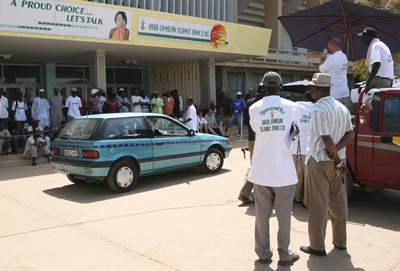
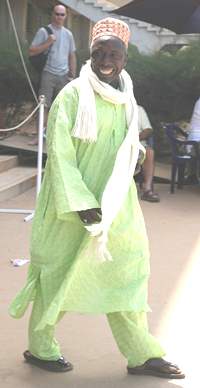 Lot number 12 was called, I drove the last 100 metres in the blue Mitsu, the bidding started at 5,000 dalasi and three minutes later it had been ‘knocked down to the man in green’ for 36,000 dalasi, £720 (about US$1450). After 7,000km it had doubled in value. Check the picture, the new owner Dehba Fofana is directly behind the car.
Lot number 12 was called, I drove the last 100 metres in the blue Mitsu, the bidding started at 5,000 dalasi and three minutes later it had been ‘knocked down to the man in green’ for 36,000 dalasi, £720 (about US$1450). After 7,000km it had doubled in value. Check the picture, the new owner Dehba Fofana is directly behind the car.
Amazing, we’d travelled through England, France, Spain, Morocco, Mauritania and Senegal to Banjul in Gambia and apart from fuel and about a litre of oil its only malfunction was a flat in Morocco, the puncture cost 10 dirhams (say 80p or US$1.60) to have fixed. What a car!






